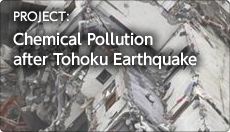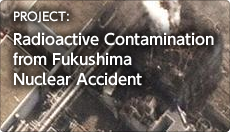
Mar,2012 : T-Watch・the Briefing Session on the Results of the Radioactive Contamination Measurement
May 10, 2012
T-Watch・the Briefing Session on the Results of the Radioactive Contamination Measurement
T-Watch director Hiraku Inoue
The first briefing session on the Radioactive Contamination Measurement Activities which have been conducted since last May by the office in Kameido,Tokyowas held on Sunday, January 29 from 1 p.m. at the Asian Rural Institute Nasu Seminar House in Nasushiobara,TochigiPrefecture.
The Network for Reduction of Toxic Chemicals (T-Watch) has been engaged in activities for effectively utilizing the published data of Pollutant Release and Transfer Register (PRTR) to reduce toxic chemicals released into the environment since it was formed 10 years ago. On March 11, 2011, at Tokyo Electric Power Company’s Fukushima No.1 nuclear power plant, core meltdowns and explosions occurred following the Great East Japan Earthquake and, in an effort to deal with this emergency, we began to research on the actual situation of toxic chemical spills from factories in the Tohoku and Kanto coastal areas caused by the giant tsunami and to take countermeasures against the radioactive contamination from the Fukushima nuclear plant.
In July of that year, with the aid of the Mitsui Environment Fund for Recovery from the Great East Japan Earthquake, we began full-scale processes for surveying the chemical contamination in the Tohoku area and for measuring the radioactive contamination of food and soil.
The purposes of the briefing session are to compile measured data so that we can share the findings with people in each area who use measuring instruments communally, and to exchange views with them on activities needed to protect against the radioactive contamination, future radiation measurement methods and so on.
In the briefing session, which about 40 producers and consumers fromMiyagiPrefecturein the north toKanagawaPrefecturein the south participated in, many heartfelt voices were raised regarding concerns about the actual state of radioactive contamination, efforts for reduction of radiation exposure, future agricultural production methods and so forth. Therefore, T-Watch once again felt keen responsibility for its radiation measurement activities.
T-Watch chief director Shigeharu Nakachi delivered an opening address and reported on the progress of its measurement activities, the current method of measuring widespread radiation released from the nuclear accident inFukushima, the reality of living environment pollution shown by the measurement results from as much as 600 samples and so on.
As requested or independent measurement activities (the latter are subsidized projects) from May 21 to the present, every weekday, radiation has been measured in about 4 samples (an average of 3.7 samples a day) with a NaI (sodium iodide) radioactivity detector for 7200, 8000, 10800 or 36000 seconds depending on the sample. The measured concentration level can be reduced to the minimum limit of determination approximately 2 Becquerel/kg, and the measuring objects include vegetables, meat, beverages, water, tea leaves, processed food, fruits, grains, soil, fallen leaves and other samples related to living environments.
Radioactive contamination is widespread, but the contamination level of each area is now becoming clearer. The purpose of the measurement activities is to reduce radiation exposure in the polluted areas. We would like to obtain more information about the contamination and indicate warnings and countermeasures from the aspect of agricultural protection in the polluted areas. Currently our independent measurement activities are carried out ① at the Asian Rural Institute in Nasushiobara, Tochigi Prefecture; ②in Ogawa-machi, Saitama Prefecture; ③ in Odawara, Kanagawa Prefecture; ④ in Kawauchi-mura, Fukushima Prefecture; and ⑤ in Nihonmatsu andIwaki,FukushimaPrefectureand other areas.
After the reports on the activities of the Asian Rural Institute and the Agro-Nature Association of Ashigara, the continual stationary measurement activities of each area were introduced as part of T-Watch’s independent measurement activities because collaborative measurement work has been carried out. Firstly, Mr. Yamaguchi at the Asian Rural Institute, which accepts Asian foreign students and teaches subsistence agriculture, mixed husbandry with livestock as major sideline and recycling-oriented organic farming, explained how they grapple with cesium contamination at the institute and what kind of efforts they make to reduce contamination as much as possible, pursuing each and every contamination measurement activity.
Ogawa-machi,SaitamaPrefecture, which is engaged in exemplary activities of the nationwide movement for organic farming, has implemented the collaborative measurement work with T-Watch as a model of a polluted area with a relatively low level of contamination. Mr. Kuwabara at Bukubuku Farm could not attend the briefing session in person because he was overseas on business, but copies of his report were handed out. The report said that his farm as an organic agriculture association in Ogawa-machi continues its efforts to uphold its own threshold of 2 Becquerel/kg under its basic policy.
The Agro-Nature Association of Ashigara in Odawara, Kanagawa Prefecture, located about 300 km from the Fukushima nuclear plant, reported that about 3000 Becquerel of cesium was detected in dried tea leaves which were picked and powdered in May this year, and that they would like to continue the collaborative measurement work with T-Watch based on the measurement results to date in their efforts to reduce contamination because they cultivate the nearby fields and conduct joint production and consumption activities with consumers.
In the special report on the efforts of Nihonmatsu, Mr. Masanori Nonaka, a professor of soil science atNiigataUniversity’s Faculty of Agriculture and a coleader of the Organic Agriculture Promotion Network Niigata, delivered a talk on the Fukushima Agricultural Reconstruction activities conducted by the “Yuki-no-Sato-Towa-Furusatozukuri” Council in Nihonmatsu,FukushimaPrefecturewith the support of the Mitsui Recovery Foundation.
Mr. Nonaka wants to share ideas with everyone, such as ① that we all are the victims of the largest-ever environmental pollution; ② that the pre-accident situation is normal, and so we should know the present real situation even if it is a painful truth and should transmit the information; ③ that Fukushima, as an agriculture-oriented prefecture, should urge the safety and security of food in Fukushima’s agriculture which had been put into practice before the accident; and ④ that we should send off information and maintain agricultural production activities in cooperation with other people in Japan until Fukushima can make the safest agricultural products in the country in 10 or 20 years. To achieve this, we must conduct research actively and disclose information to “visualize fear and share information between producers and consumers,” and must clarify the responsibility of Tokyo Electric Power Company. He continued as follows. In the farmland ofJapan, especiallyFukushima, soil fertility has been improved utilizing Satoyama resources and livestock compost. It has been found out that cesium is hardly transferred from such soil into farm products. Although radioactive fallout was deposited and accumulated in open-field spring vegetables and other things, it was hardly absorbed into farm products from soil and was not absorbed into summer vegetables and so on.
We can get over the radiation disaster by continuing farming activities. Cesium in the fields can be significantly reduced through our cultivating efforts. Cesium mixed in soil is strongly retained by soil, and far less Cesium is transferred into farm products than originally expected. From now on, what we should care about are ① to take precautions against the flow of cesium from Satoyama forest into paddy fields through infiltration water or rainwater. This requires maintenance of Satoyama forest near terraced paddy fields; ② to pay attention to water management during the rice-growing season because cesium can be absorbed not only from soil but also from young roots of rice in paddy water throughout the rice-growing season; ③ to prevent the inflow from irrigation upstream and reservoirs; ④ to make efforts for improvement of soil fertility after rice reaping and so on.
Mr. Nonaka concluded his speech with the following words: Producers should present consumers with the method of growing crops suggesting “food is medicine” and “farm products are food and also medicine” and should send information through the air, but at the same time, consumers should be aware that how they eat and what they choose to eat decides Japanese “food” and, further, “the future of agriculture”. It is extremely important that producers and consumers coordinate closely with each other. Ordinary farming activities will salvage communities and their livelihoods, and the radiation crisis can be overcome only by the agriculture in good harmony with nature in each community.
| ItemCategory | Number of Measurement Activities | Cesium(Bq/kg)* | Numberof ND | ND % | ||
| Minimum Value | Maximum Value | |||||
| vegetables |
140 |
3 |
4,800 |
82 |
59 |
|
| potatoes |
48 |
5 |
32 |
31 |
65 |
|
| rootcrops |
15 |
3 |
7 |
11 |
73 |
|
| fruit vegetables・onions |
24 |
4 |
10 |
18 |
75 |
|
| leaf vegetables |
34 |
5 |
58 |
21 |
62 |
|
| field mustard |
4 |
25 |
3,400 |
0 |
0 |
|
| rapeseed |
7 |
12 |
810 |
0 |
0 |
|
| mushrooms |
7 |
7 |
4,800 |
1 |
14 |
|
| bracken |
1 |
|
1,140 |
0 |
0 |
|
| meet |
7 |
8 |
17 |
1 |
14 |
|
| eggs |
6 |
5 |
7 |
4 |
67 |
|
| beverages・water |
32 |
4 |
17 |
28 |
88 |
|
| tea leaves |
18 |
17 |
3,300 |
3 |
17 |
|
| processed food |
7 |
4 |
4 |
6 |
86 |
|
| fruits |
18 |
6 |
187 |
5 |
28 |
|
| grain |
151 |
3 |
600 |
63 |
42 |
|
| rice plants・paddy |
11 |
9 |
95 |
6 |
55 |
|
| brown rice |
68 |
3 |
213 |
30 |
44 |
|
| white rice |
28 |
3 |
44 |
15 |
54 |
|
| wheat |
21 |
4 |
98 |
2 |
10 |
|
| beans |
11 |
4 |
38 |
4 |
36 |
|
| feed etc. |
12 |
6 |
600 |
6 |
50 |
|
| soil |
155 |
3 |
370,000 |
2 |
1 |
|
| rice fields |
19 |
6 |
16,700 |
0 |
0 |
|
| plowed fields・fruit farms |
90 |
11 |
176,000 |
2 |
2 |
|
| gardens・residentialareas |
36 |
3 |
370,000 |
0 |
0 |
|
| parks・streets |
10 |
52 |
235,000 |
0 |
0 |
|
| fallen leaves |
19 |
8 |
9,000 |
0 |
0 |
|
| the others |
27 |
2 |
21,800 |
7 |
26 |
|
*The detection limit is considered to be 2 Becquerel based on the recent measurement results.


